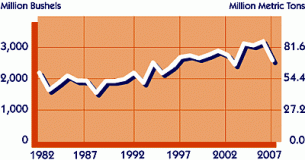The History of Soy

U.S. soybean production 1982 - 2007 (www.soystats.com)
American agriculture has recognized soybeans’ versatility only relatively recently. Though they've only been farmed seriously in this country since the late 19th century, they have been used as a food source in Asia for thousands of years, domesticated from the wild Glycine soja. Geneticists believe they can trace the first plants to the eastern half of China, and by 600 B.C. poets were even writing about the soybean, at that point probably used in soups and stews. Some experts think that tofu itself was on Chinese dinner tables by the time of Christ’s arrival.
In this country, soyfoods, including tofu, began to surface in Asian neighborhoods of big cities around the 1920s, as well as among Seventh Day Adventist Christians and health proponents like Dr. John Harvey Kellogg.
But tofu wasn’t what popularized the soybean. With crude science and processing methods, early soyfoods were said to be bland and boring; the American population just wasn’t buying—or eating—them. In the end, it was the devastation of southern cotton that helped propel soy onto the main stage. In 1915, the cotton crop that Americans had been relying on for, among other things, cottonseed oil, suffered drastic effects at the mouths of the Boll Weevil.
Chemists, forced to find a new oil source, turned their microscopes to soy. When they deconstructed the bean they found that it had wide uses as both a feedstock protein and oil source. As a result, farming soybeans began to gain broader acceptance, now as the domesticated Glycine max.
Between 1965-1990, American soy production rose over 300 percent as the worldwide demand for soybean meal and oil increased, and the U.S. quickly became the world’s largest soy grower. According to the USDA, in 2008 the U.S. produced about 89 million tons of soybeans, 30 million of which were exported to China, Mexico, Europe and Japan, representing 37 percent of the world’s soybean trade.
In this country, soyfoods, including tofu, began to surface in Asian neighborhoods of big cities around the 1920s, as well as among Seventh Day Adventist Christians and health proponents like Dr. John Harvey Kellogg.
But tofu wasn’t what popularized the soybean. With crude science and processing methods, early soyfoods were said to be bland and boring; the American population just wasn’t buying—or eating—them. In the end, it was the devastation of southern cotton that helped propel soy onto the main stage. In 1915, the cotton crop that Americans had been relying on for, among other things, cottonseed oil, suffered drastic effects at the mouths of the Boll Weevil.
Chemists, forced to find a new oil source, turned their microscopes to soy. When they deconstructed the bean they found that it had wide uses as both a feedstock protein and oil source. As a result, farming soybeans began to gain broader acceptance, now as the domesticated Glycine max.
Between 1965-1990, American soy production rose over 300 percent as the worldwide demand for soybean meal and oil increased, and the U.S. quickly became the world’s largest soy grower. According to the USDA, in 2008 the U.S. produced about 89 million tons of soybeans, 30 million of which were exported to China, Mexico, Europe and Japan, representing 37 percent of the world’s soybean trade.
